Improved Sugarcane-Based Fermentation Processes by an Industrial Fuel-Ethanol Yeast Strain
Abstract
1. Introduction
2. Materials and Methods
2.1. Strains, Media, and Growth Conditions
2.2. Array-CGH Protocol
2.3. PFGE, Chromosome Blotting and Hybridization
2.4. Determination of Invertase Activity
2.5. Determination of the Activity of the AGT1 Permease
2.6. Molecular Biology Techniques
2.7. Sucrose Batch Fermentations
3. Results and Discussion
3.1. Microarray Karyotyping of Industrial Yeast Strains Used in Sugarcane-Based Fermentation Processes
3.2. Invertase Activity of Industrial Yeast Strains Used in Sugarcane-Based Fermentation Processes
3.3. Sucrose Batch Fermentation by the Industrial Yeast Strains Used in Sugarcane-Based Fermentation Processes
3.4. Modifying the Mode of Sucrose Fermentation by an Industrial Fuel-Ethanol Yeast Strain
4. Practical Implications of this Study
Supplementary Materials
Author Contributions
Funding
Institutional Review Board Statement
Informed Consent Statement
Data Availability Statement
Acknowledgments
Conflicts of Interest
References
- Goldemberg, J. Ethanol for a sustainable energy future. Science 2007, 315, 808–810. [Google Scholar] [CrossRef]
- CONAB—Companhia Nacional de Abastecimento—Acompanhamento da Safra Brasileira de Cana-de-Açúcar—Safra 2022/23. Available online: https://www.conab.gov.br/info-agro/safras/cana/boletim-da-safra-de-cana-de-acucar (accessed on 2 March 2023).
- Jaiswal, D.; de Souza, A.P.; Larsen, S.; LeBauer, D.S.; Miguez, F.E.; Sparovek, G.; Bollero, G.; Buckeridge, M.S.; Long, S.P. Brazilian sugarcane ethanol as an expandable green alternative to crude oil use. Nat. Clim. Chang. 2017, 7, 788–792. [Google Scholar] [CrossRef]
- Jacobus, A.P.; Gross, J.; Evans, J.H.; Ceccato-Antonini, S.R.; Gombert, A.K. Saccharomyces cerevisiae strains used industrially for bioethanol production. Essays Biochem. 2021, 65, 147–161. [Google Scholar] [CrossRef] [PubMed]
- do Nascimento e Silva, J.H.; Verruma-Bernardi, M.R.; de Oliveira, A.L. Cachaça production in Brazil and its main contaminant (ethyl carbamate). Sci. Agric. 2018, 77, e20180135. [Google Scholar] [CrossRef]
- Amorim, H.V.; Lopes, M.L.; Oliveira, J.V.C.; Buckeridge, M.S.; Goldman, G.H. Scientific challenges of bioethanol production in Brazil. Appl. Microbiol. Biotechnol. 2011, 91, 1267–1275. [Google Scholar] [CrossRef]
- Lopes, M.L.; Paulillo, S.C.; Godoy, A.; Cherubin, R.A.; Lorenzi, M.S.; Giometti, F.H.; Bernardino, C.D.; Amorim Neto, H.B.; Amorim, H.V. Ethanol production in Brazil: A bridge between science and industry. Braz. J. Microbiol. 2016, 47 (Suppl. S1), 64–76. [Google Scholar] [CrossRef]
- Badotti, F.; Gomes, F.C.O.; Rosa, C.A. Brazilian cachaça: Fermentation and production. In Handbook of Plant-Based Fermented Food and Beverage Technology, 2nd ed.; Hui, Y.H., Evranuz, E.Ö., Eds.; CRC Press: Boca Raton, FL, USA, 2012; pp. 639–648. [Google Scholar]
- Guerra, J.B.; Araújo, R.A.; Pataro, C.; Franco, G.R.; Moreira, E.S.; Mendonça-Hagler, L.C.; Rosa, C.A. Genetic diversity of Saccharomyces cerevisiae strains during the 24 h fermentative cycle for the production of the artisanal Brazilian cachaça. Lett. Appl. Microbiol. 2001, 33, 106–111. [Google Scholar] [CrossRef]
- da Silva-Filho, E.; Santos, S.K.; Resende, A.M.; Morais, J.O.; de Morais-Jr, M.A.; Simões, D.A. Yeast population dynamics of industrial fuel-ethanol fermentation process assessed by PCR-fingerprinting. Antonie Leeuwenhoeck 2005, 88, 13–23. [Google Scholar] [CrossRef]
- Badotti, F.; Rosa, C.A.; Stambuk, B.U. Biochemical and molecular characterization of Saccharomyces cerevisiae strains isolated from artisan-type fermentations of sugarcane and molasses in the production of sugarcane brandy in Florianópolis-SC, Brazil. Braz. J. Food Technol. 2010, 13, 205–213. [Google Scholar] [CrossRef]
- Basso, L.C.; de Amorim, H.V.; de Oliveira, A.J.; Lopes, M.L. Yeast selection for fuel ethanol production in Brazil. FEMS Yeast Res. 2008, 8, 1155–1163. [Google Scholar] [CrossRef] [PubMed]
- Gomes, F.C.; Silva, C.L.; Marini, M.M.; Oliveira, E.S.; Rosa, C.A. Use of selected indigenous Saccharomyces cerevisiae strains for the production of the traditional cachaça in Brazil. J. Appl. Microbiol. 2007, 103, 2438–2447. [Google Scholar] [CrossRef]
- Campos, C.R.; Silva, C.F.; Dias, D.R.; Basso, L.C.; Amorim, H.V.; Schwan, R.F. Features of Saccharomyces cerevisiae as a culture starter for the production of the distilled sugar cane beverage, cachaça in Brazil. J. Appl. Microbiol. 2010, 108, 1871–1879. [Google Scholar] [CrossRef] [PubMed]
- Marques, W.L.; Raghavendran, V.; Stambuk, B.U.; Gombert, A.K. Sucrose and Saccharomyces cerevisiae: A relationship most sweet. FEMS Yeast Res. 2016, 16, fov107. [Google Scholar] [CrossRef] [PubMed]
- Korshunova, I.V.; Naumova, E.S.; Naumov, G.I. Comparative molecular genetic analysis of β-fructosidases of yeasts Saccharomyces. Mol. Biol. 2005, 39, 413–419. [Google Scholar] [CrossRef]
- Naumova, E.S.; Sadykova, A.Z.; Martynenko, N.N.; Naumov, G.I. Molecular polymorphism of β-fructosidase SUC genes in the Saccharomyces yeasts. Mol. Biol. 2014, 48, 573–582. [Google Scholar] [CrossRef]
- Codón, A.C.; Benítez, T.; Korhola, M. Chromosomal polymorphism and adaptation to specific industrial environments of Saccharomyces strains. Appl. Microbiol. Biotechnol. 1998, 49, 154–163. [Google Scholar] [CrossRef]
- Naumova, E.S.; Sadykova, A.Z.; Martynenko, N.N.; Naumov, G.I. Molecular genetic characteristics of Saccharomyces cerevisiae distillers’ yeasts. Microbiology 2013, 82, 175–185. [Google Scholar] [CrossRef]
- Carlson, M.; Botstein, D. Two differentially regulated mRNAs with different 5’ ends encode secreted with intracellular forms of yeast invertase. Cell 1982, 28, 145–154. [Google Scholar] [CrossRef]
- Herwing, C.; Doerries, C.; Marison, I.; von Stockar, U. Quantitative analysis of the regulation scheme of invertase expression in Saccharomyces cerevisiae. Biotechnol. Bioeng. 2001, 76, 247–258. [Google Scholar] [CrossRef]
- Belinchón, M.M.; Gancedo, J.M. Different signaling pathways mediate glucose induction of SUC2, HXT1 and pyruvate decarboxylase in yeast. FEMS Yeast Res. 2007, 7, 40–47. [Google Scholar] [CrossRef]
- Takeshige, K.; Ouchi, K. Effects of yeast invertase on ethanol production in molasses. J. Ferment. Bioeng. 1995, 79, 513–515. [Google Scholar] [CrossRef]
- Myers, D.K.; Lawlor, D.T.M.; Attfield, P.V. Influence of invertase activity and glycerol synthesis and retention on fermentation of media with a high sugar concentration by Saccharomyces cerevisiae. Appl. Environ. Microbiol. 1997, 63, 145–150. [Google Scholar] [CrossRef] [PubMed]
- Greig, D.; Travisano, M. The Prisoner’s Dilemma and polymorphism in yeast SUC genes. Proc. Biol. Sci. 2004, 271 (Suppl. S3), S25–S26. [Google Scholar] [CrossRef] [PubMed]
- Gore, J.; Youk, H.; Oudenaarden, A. Snowdrift game dynamics and facultative cheating in yeast. Nature 2009, 459, 253–256. [Google Scholar] [CrossRef] [PubMed]
- Stambuk, B.U.; Batista, A.S.; de Araujo, P.S. Kinetics of active sucrose transport in Saccharomyces cerevisiae. J. Biosci. Bioeng. 2000, 89, 212–214. [Google Scholar] [CrossRef]
- Batista, A.S.; Miletti, L.C.; Stambuk, B.U. Sucrose fermentation by Saccharomyces cerevisiae lacking hexose transport. J. Mol. Microbiol. Biotechnol. 2004, 8, 26–33. [Google Scholar] [CrossRef]
- Badotti, F.; Dário, M.G.; Alves-Jr, S.L.; Cordioli, M.L.; Miletti, L.C.; de Araujo, P.S.; Stambuk, B.U. Switching the mode of sucrose utilization by Saccharomyces cerevisiae. Microb. Cell Fact. 2008, 7, 4. [Google Scholar] [CrossRef]
- Brown, C.A.; Murray, A.W.; Verstrepen, K.J. Rapid expansion and functional divergence of subtelomeric gene families in yeasts. Curr. Biol. 2010, 20, 895–903. [Google Scholar] [CrossRef]
- Marques, W.L.; Mans, R.; Marella, E.R.; Cordeiro, R.L.; van den Broek, M.; Daran, J.G.; Pronk, J.T.; Gombert, A.K.; van Maris, A.J. Elimination of sucrose transport and hydrolysis in Saccharomyces cerevisiae: A platform strain for engineering sucrose metabolism. FEMS Yeast Res. 2017, 17, fox006. [Google Scholar] [CrossRef]
- Basso, T.O.; de Kok, S.; Dario, M.; do Espirito-Santo, J.C.; Müller, G.; Schlölg, P.S.; Silva, C.P.; Tonso, A.; Daran, J.M.; Gombert, A.K.; et al. Engineering topology and kinetics of sucrose metabolism in Saccharomyces cerevisiae for improved ethanol yield. Metab. Eng. 2011, 13, 694–703. [Google Scholar] [CrossRef]
- Gombert, A.K.; van Maris, A.J. Improving conversion yield of fermentable sugars into fuel ethanol in 1st generation yeast-based production processes. Curr. Opin. Biotechnol. 2015, 33, 81–86. [Google Scholar] [CrossRef]
- van Aalst, A.C.A.; de Valk, S.C.; van Gulik, W.M.; Jansen, M.L.A.; Pronk, J.T.; Mans, R. Pathway engineering strategies for improved product yield in yeast-based industrial ethanol production. Synth. Syst. Biotechnol. 2022, 7, 554–566. [Google Scholar] [CrossRef]
- Zahoor, A.; Messerschmidt, K.; Boecker, S.; Klamt, S. ATPase-based implementation of enforced ATP wasting in Saccharomyces cerevisiae for improved ethanol production. Biotechnol. Biofuels 2020, 13, 185. [Google Scholar] [CrossRef] [PubMed]
- Semkiv, M.V.; Dmytruk, K.V.; Abbas, C.A.; Sibirny, A.A. Increased ethanol accumulation from glucose via reduction of ATP level in a recombinant strain of Saccharomyces cerevisiae overexpressing alkaline phosphatase. BMC Biotechnol. 2014, 14, 42. [Google Scholar] [CrossRef][Green Version]
- de Valk, S.C.; Bouwmeester, S.E.; de Hulster, E.; Mans, R. Engineering proton-coupled hexose uptake in Saccharomyces cerevisiae for improved ethanol yield. Biotechnol. Biofuels 2022, 15, 47. [Google Scholar] [CrossRef] [PubMed]
- Varize, C.S.; Bücker, A.; Lopes, L.D.; Christofoleti-Furlan, R.M.; Raposo, M.S.; Basso, L.C.; Stambuk, B.U. Increasing ethanol tolerance and ethanol production in an industrial fuel ethanol Saccharomyces cerevisiae strain. Fermentation 2022, 8, 470. [Google Scholar] [CrossRef]
- Eliodório, K.P.; de Gois e Cunha, G.C.; White, B.A.; Patel, D.H.M.; Zhang, F.; Hettema, E.H.; Basso, T.O.; Gombert, A.K.; Raghavendran, V. Blocking mitophagy does not significantly improve fuel ethanol production in bioethanol yeast Saccharomyces cerevisiae. Appl. Environ. Microbiol. 2022, 88, e0206821. [Google Scholar] [CrossRef]
- de Figueiredo, C.M.; Hock, D.H.; Trichez, D.; Magalhães, M.d.L.B.; Lopes, M.L.; de Amorim, H.V.; Stambuk, B.U. High foam phenotypic diversity and variability in flocculant gene observed for various yeast cell surfaces present as industrial contaminants. Fermentation 2021, 7, 127. [Google Scholar] [CrossRef]
- Stambuk, B.U.; Dunn, B.; Alves-Jr, S.L.; Duval, E.H.; Sherlock, G. Industrial fuel ethanol yeasts contain adaptive copy number changes in genes involved in vitamin B1 and B6 biosynthesis. Genome Res. 2009, 19, 2271–2278. [Google Scholar] [CrossRef] [PubMed]
- Oliveira, E.S.; Rosa, C.A.; Morgano, M.A. Fermentation characteristics as criteria for selection of cachaça yeast. World J. Microbiol. Biotechnol. 2004, 20, 19–24. [Google Scholar] [CrossRef]
- Marini, M.M.; Gomes, F.C.O.; Silva, C.L.C.; Cadete, R.M.; Badotti, F.; Oliveira, E.S.; Cardoso, C.R.; Rosa, C.A. The use of selected starter Saccharomyces cerevisiae strains to produce traditional and industrial cachaça: A comparative study. World J. Microbiol. Biotechnol. 2009, 25, 235–242. [Google Scholar] [CrossRef]
- Duval, E.H.; Alves-Jr, S.L.; Dunn, B.; Sherlock, G.; Stambuk, B.U. Microarray karyotyping of maltose-fermenting Saccharomyces yeasts with differing maltotriose utilization profiles reveals copy number variation in genes involved in maltose and maltotriose utilization. J. Appl. Microbiol. 2010, 109, 248–259. [Google Scholar] [CrossRef] [PubMed]
- DeRisi, J.L.; Iyer, V.R.; Brown, P.O. Exploring the metabolic and genetic control of gene expression on a genomic scale. Science 1997, 278, 680–686. [Google Scholar] [CrossRef] [PubMed]
- Wang, P.; Kim, Y.; Pollack, J.; Narasimhan, B.; Tibshirani, R. A method for calling gains and losses in array CGH data. Biostatistics 2005, 6, 45–58. [Google Scholar] [CrossRef]
- Jules, M.; Guillou, V.; François, J.; Parrou, J.L. Two distinct pathways for trehalose assimilation in the yeast Saccharomyces cerevisiae. Appl. Environ. Microbiol. 2004, 70, 2771–2778. [Google Scholar] [CrossRef]
- Petracek, M.E.; Longtine, M.S. PCR-based engineering of yeast genome. Methods Enzymol. 2002, 350, 445–469. [Google Scholar] [CrossRef]
- Silveira, M.C.; Carvajal, E.; Bom, E.P. Assay for in vivo yeast invertase activity using NaF. Anal. Biochem. 1996, 238, 26–28. [Google Scholar] [CrossRef]
- Stambuk, B.U. A simple experiment illustrating metabolic regulation: Induction versus repression of yeast α-glucosidase. Biochem. Educ. 1999, 27, 177–180. [Google Scholar] [CrossRef]
- Hollatz, C.; Stambuk, B.U. Colorimetric determination of active α-glucoside transport in Saccharomyces cerevisiae. J. Microbiol. Methods. 2001, 46, 253–259. [Google Scholar] [CrossRef]
- Ausubel, F.M.; Brent, R.; Kingston, R.E.; Moore, D.D.; Seidman, J.G.; Smith, J.A.; Struhl, K. Short Protocols in Molecular Biology, 3rd ed.; John Wiley & Sons: New York, NY, USA, 1995. [Google Scholar]
- Gietz, D.; St Jean, A.; Woods, R.A.; Schiestl, R.H. Improved method for high efficiency transformation of intact yeast cells. Nucleic Acids Res. 1992, 20, 1425. [Google Scholar] [CrossRef]
- Badotti, F.; Batista, A.S.; Stambuk, B.U. Sucrose active transport and fermentation by Saccharomyces cerevisiae. Braz. Arch. Biol. Technol. 2006, 49 (Suppl. S1), 115–123. [Google Scholar]
- Bastos, R.W.; Pedroso, S.H.; Vieira, A.T.; Moreira, L.M.; França, C.S.; Cartelle, C.T.; Arantes, R.M.; Generoso, S.V.; Cardoso, V.N.; Neves, M.J.; et al. Saccharomyces cerevisiae UFMG A-905 treatment reduces intestinal damage in a murine model of irinotecan-induced mucositis. Benef. Microbes. 2016, 7, 549–557. [Google Scholar] [CrossRef]
- Miranda, V.C.; Santos, S.S.; Assis, H.C.; Faria, A.M.C.; Quintanilha, M.F.; Morão, R.P.; Nicoli, J.R.; Cara, D.C.; Martins, F.S. Effect of Saccharomyces cerevisiae UFMG A-905 in a murine model of food allergy. Benef. Microbes. 2020, 11, 255–268. [Google Scholar] [CrossRef] [PubMed]
- Saldanha, A.J. Java Treeview—Extensible visualization of microarray data. Bioinformatics 2004, 20, 3246–3248. [Google Scholar] [CrossRef] [PubMed]
- Reifenberger, E.; Freidel, K.; Ciriacy, M. Identification of novel HXT genes in Saccharomyces cerevisiae reveals the impact of individual hexose transporters on glycolytic flux. Mol. Microbiol. 1995, 16, 157–167. [Google Scholar] [CrossRef] [PubMed]
- Diderich, J.A.; Schepper, M.; van Hoek, P.; Luttik, M.A.; van Dijken, J.P.; Pronk, J.T.; Klaassen, P.; Boelens, H.F.; de Mattos, M.J.; van Dam, K.; et al. Glucose uptake kinetics and transcription of HXT genes in chemostat cultures of Saccharomyces cerevisiae. J. Biol. Chem. 1999, 274, 15350–15359. [Google Scholar] [CrossRef]
- Ozcan, S.; Johnston, M. Function and regulation of yeast hexose transporters. Microbiol. Mol. Biol. Rev. 1999, 63, 554–569. [Google Scholar] [CrossRef]
- Jordan, P.; Choe, J.Y.; Boles, E.; Oreb, M. Hxt13, Hxt15, Hxt16 and Hxt17 from Saccharomyces cerevisiae represent a novel type of polyol transporters. Sci. Rep. 2016, 6, 23502. [Google Scholar] [CrossRef]
- Donnini, C.; Lodi, T.; Ferrero, I.; Algeri, A.; Puglisi, P.P. Allelism of IMP1 and GAL2 genes of Saccharomyces cerevisiae. J. Bacteriol. 1992, 174, 3411–3415. [Google Scholar] [CrossRef][Green Version]
- Paxhia, M.D.; Downs, D.M. SNZ3 encodes a PLP synthase involved in thiamine synthesis in Saccharomyces cerevisiae. G3: Gen. Genom. Genet. 2019, 9, 335–344. [Google Scholar] [CrossRef]
- Jacobus, A.P.; Stephens, T.G.; Youssef, P.; González-Pech, R.; Ciccotosto-Camp, M.M.; Dougan, K.E.; Chen, Y.; Basso, L.C.; Frazzon, J.; Chan, C.X.; et al. Comparative genomics supports that Brazilian bioethanol Saccharomyces cerevisiae comprise a unified group of domesticated strains related to cachaça spirit yeasts. Front. Microbiol. 2021, 12, 644089. [Google Scholar] [CrossRef] [PubMed]
- McIlwain, S.J.; Peris, D.; Sardi, M.; Moskvin, O.V.; Zhan, F.; Myers, K.S.; Riley, N.M.; Buzzell, A.; Parreiras, L.S.; Ong, I.M.; et al. Genome sequence and analysis of a stress-tolerant, wild-derived strain of Saccharomyces cerevisiae used in biofuels research. G3: Gen. Genom. Genet. 2016, 6, 1757–1766. [Google Scholar] [CrossRef]
- Nosaka, K. Recent progress in understanding thiamin biosynthesis and its genetic regulation in Saccharomyces cerevisiae. Appl. Microbiol. Biotechnol. 2006, 72, 30–40. [Google Scholar] [CrossRef] [PubMed]
- Mojzita, D.; Hohmann, S. Pdc2 coordinates expression of the THI regulon in the yeast Saccharomyces cerevisiae. Mol. Genet. Genomics 2006, 276, 147–161. [Google Scholar] [CrossRef] [PubMed]
- Labuschagne, P.; Divol, B. Thiamine: A key nutrient for yeasts during wine alcoholic fermentation. Appl. Microbiol. Biotechnol. 2021, 105, 953–973. [Google Scholar] [CrossRef] [PubMed]
- Legras, J.L.; Merdinoglu, D.; Cornuet, J.M.; Karst, F. Bread, beer and wine: Saccharomyces cerevisiae diversity reflects human history. Mol. Ecol. 2007, 16, 2091–2102. [Google Scholar] [CrossRef]
- Liti, G.; Carter, D.M.; Moses, A.M.; Warringer, J.; Parts, L.; James, S.A.; Davey, R.P.; Roberts, I.N.; Burt, A.; Koufopanou, V.; et al. Population genomics of domestic and wild yeasts. Nature 2009, 458, 337–341. [Google Scholar] [CrossRef]
- Peter, J.; de Chiara, M.; Friedrich, A.; Yue, J.X.; Pflieger, D.; Bergström, A.; Sigwalt, A.; Barre, B.; Freel, K.; Llored, A.; et al. Genome evolution across 1011 Saccharomyces cerevisiae isolates. Nature 2018, 556, 339–344. [Google Scholar] [CrossRef]
- Liu, Z.L.; Huang, X. Copy number variants impact phenotype-genotype relationships for adaptation of industrial yeast Saccharomyces cerevisiae. Appl. Microbiol. Biotechnol. 2022, 106, 6611–6623. [Google Scholar] [CrossRef]
- Barbosa, R.; Pontes, A.; Santos, R.O.; Montandon, G.G.; de Ponzzes-Gomes, C.M.; Morais, P.B.; Gonçalves, P.; Rosa, C.A.; Sampaio, J.P. Multiple rounds of artificial selection promote microbe secondary domestication-The case of cachaça yeasts. Genome Biol. Evol. 2018, 10, 1939–1955. [Google Scholar] [CrossRef]
- Rego-Costa, A.; Huang, I.T.; Desai, M.M.; Gombert, A.K. Yeast population dynamics in Brazilian bioethanol production. G3: Gen. Genom. Genet. 2023, 13, kad104. [Google Scholar] [CrossRef] [PubMed]
- Ozcan, S.; Vallier, L.G.; Flick, J.S.; Carlson, M.; Johnston, M. Expression of the SUC2 gene of Saccharomyces cerevisiae is induced by low levels of glucose. Yeast 1997, 13, 127–137. [Google Scholar] [CrossRef]
- Babrzadeh, F.; Jalili, R.; Wang, C.; Shokralla, S.; Pierce, S.; Robinson-Mosher, A.; Nyren, P.; Shafer, R.W.; Basso, L.C.; de Amorim, H.V.; et al. Whole-genome sequencing of the efficient industrial fuel-ethanol fermentative Saccharomyces cerevisiae strain CAT-1. Mol. Genet. Genomics 2012, 287, 485–494. [Google Scholar] [CrossRef]
- Vidgren, V.; Kankainen, M.; Londesborough, J.; Ruohonen, L. Identification of regulatory elements in the AGT1 promoter of ale and lager strains of brewer’s yeast. Yeast 2011, 28, 579–594. [Google Scholar] [CrossRef] [PubMed]
- Alves-Jr, S.L.; Thevelein, J.M.; Stambuk, B.U. Extracellular maltotriose hydrolysis by Saccharomyces cerevisiae cells lacking the AGT1 permease. Lett. Appl. Microbiol. 2018, 67, 377–383. [Google Scholar] [CrossRef]
- Vidgren, V.; Huuskonen, A.; Virtanen, H.; Ruohonen, L.; Londesborough, J. Improved fermentation performance of a lager yeast after repair of its AGT1 maltose and maltotriose transporter genes. Appl. Environ. Microbiol. 2009, 75, 2333–2345. [Google Scholar] [CrossRef][Green Version]
- Alves-Jr, S.L.; Herberts, R.A.; Hollatz, C.; Miletti, L.C.; Stambuk, B.U. Maltose and maltotriose active transport and fermentation by Saccharomyces cerevisiae. J. Am. Soc. Brew. Chem. 2007, 65, 99–104. [Google Scholar] [CrossRef]
- Pereira, L.F.; Lucatti, E.; Basso, L.C.; de Morais-Jr, M.A. The fermentation of sugarcane molasses by Dekkera bruxellensis and the mobilization of reserve carbohydrates. Antonie Leeuwenhoek 2014, 105, 481–489. [Google Scholar] [CrossRef]
- Erasmus, D.J.; van der Merwe, G.K.; van Vuuren, H.J. Genome-wide expression analyses: Metabolic adaptation of Saccharomyces cerevisiae to high sugar stress. FEMS Yeast Res. 2003, 3, 375–399. [Google Scholar] [CrossRef]
- Parmar, J.H.; Bhartiya, S.; Venkatesh, K.V. Characterization of the adaptive response and growth upon hyperosmotic shock in Saccharomyces cerevisiae. Mol. Biosyst. 2011, 7, 1138–1148. [Google Scholar] [CrossRef]
- Petelenz-Kurdziel, E.; Kuehn, C.; Nordlander, B.; Klein, D.; Hong, K.K.; Jacobson, T.; Dahl, P.; Schaber, J.; Nielsen, J.; Hohmann, S.; et al. Quantitative analysis of glycerol accumulation, glycolysis and growth under hyper osmotic stress. PLoS Comput. Biol. 2013, 9, e1003084. [Google Scholar] [CrossRef] [PubMed]
- Blomberg, A. Yeast osmoregulation—Glycerol still in pole position. FEMS Yeast Res. 2022, 22, foac035. [Google Scholar] [CrossRef] [PubMed]
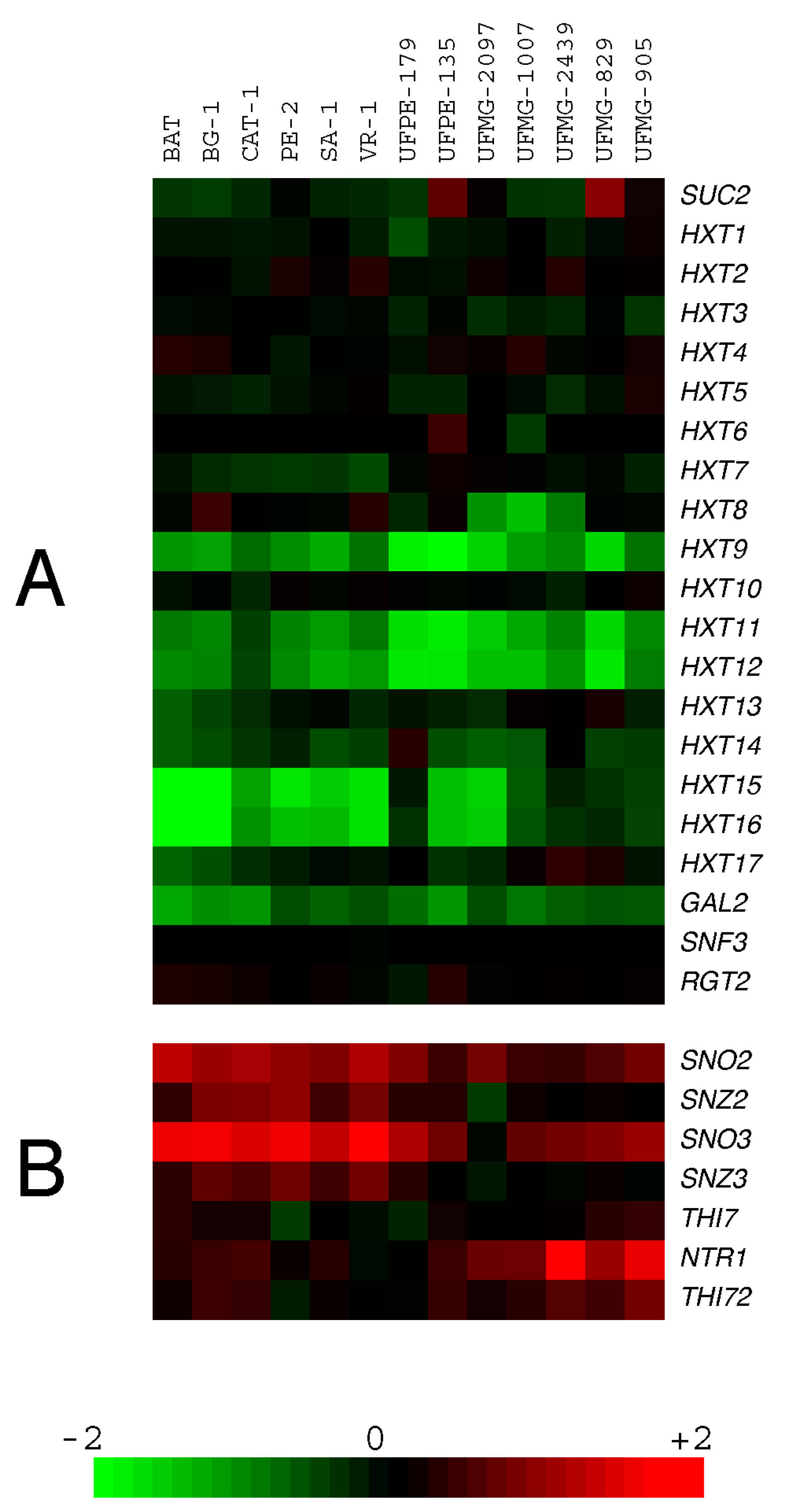
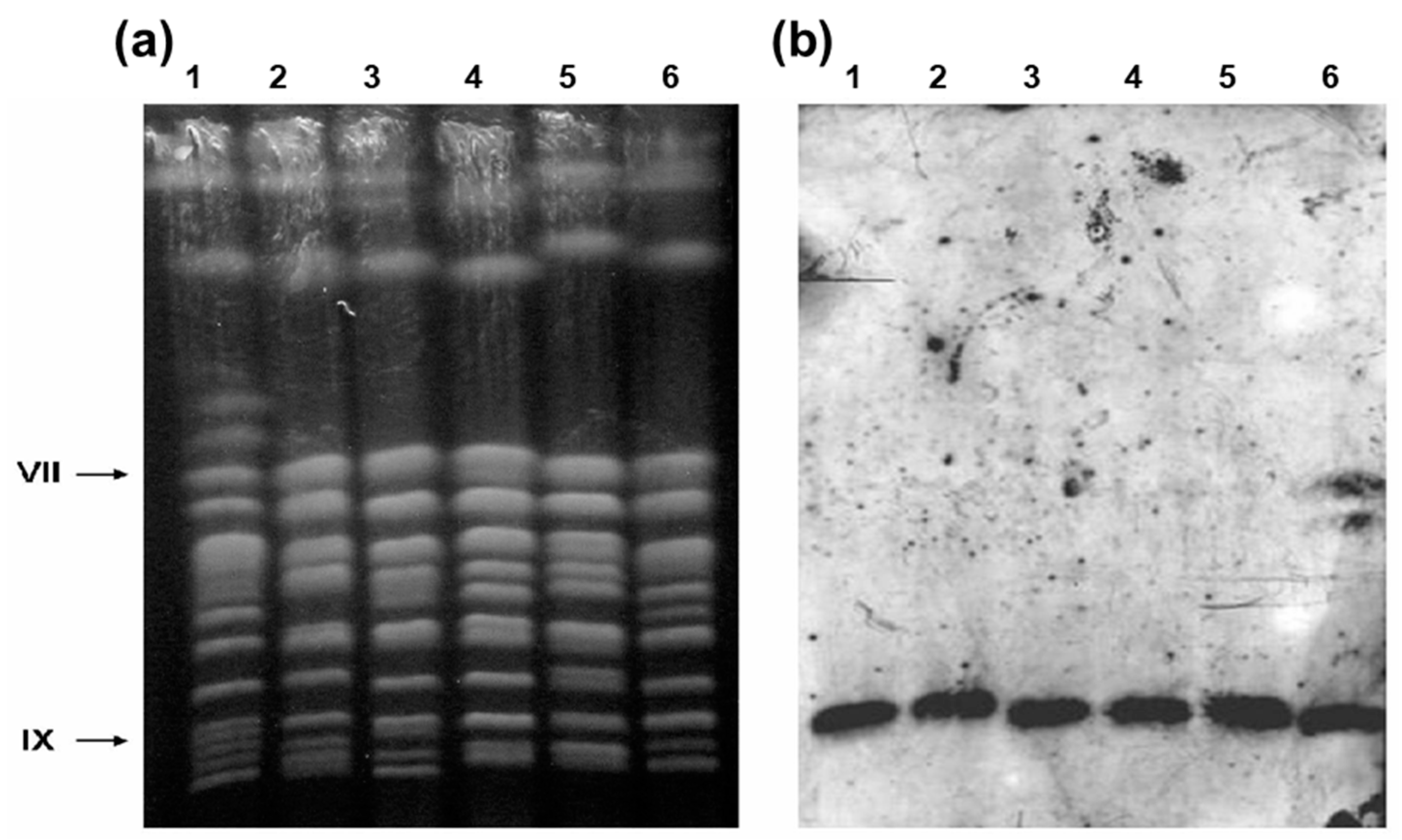
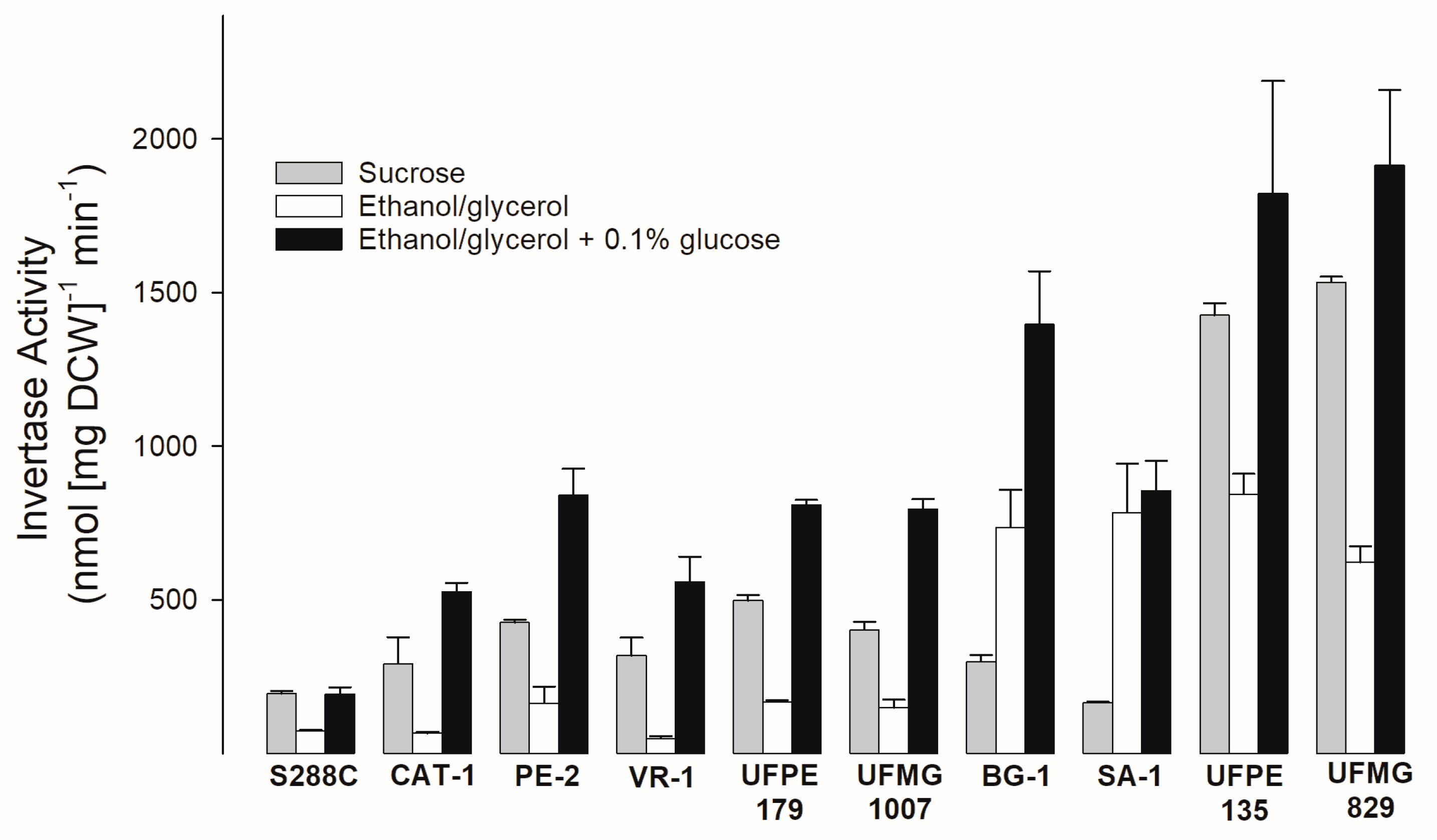
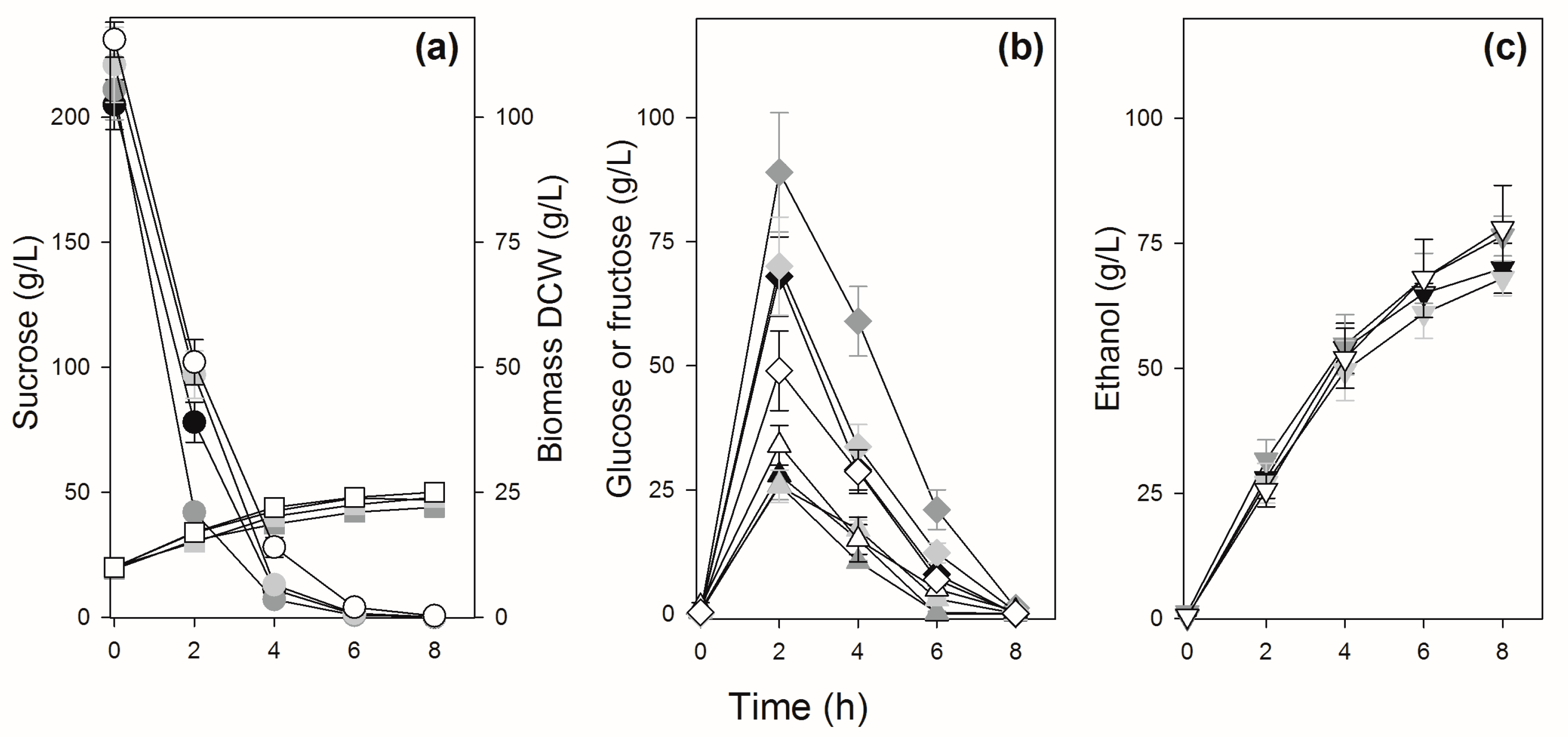

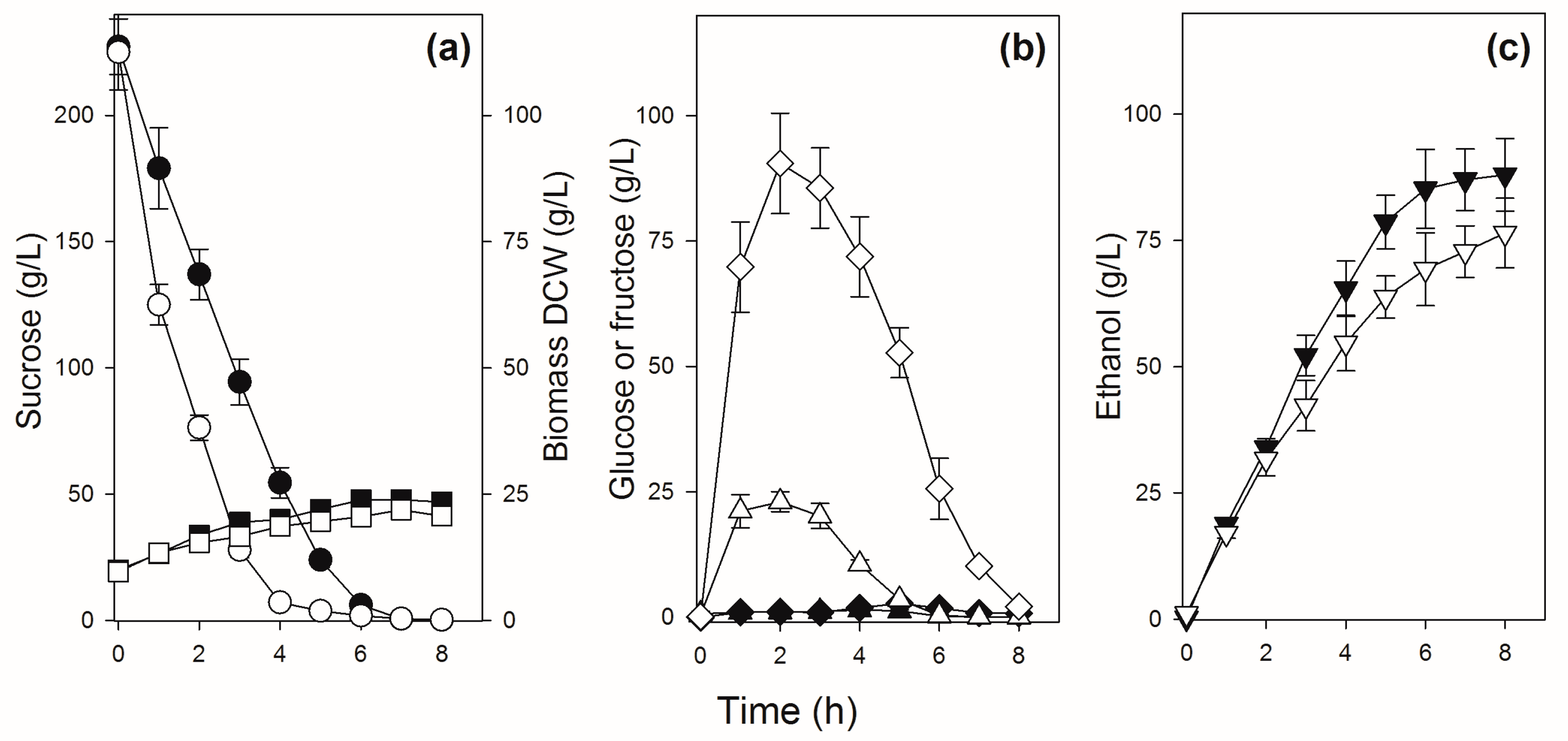
| Yeast Strains | Relevant Features | Source |
|---|---|---|
| BAT | Industrial fuel-ethanol strain isolated in 2011 from Usina Batatais, São Paulo, Brazil. | [40] |
| BG-1 | Industrial fuel-ethanol strain isolated in 1989/1990 from Usina Barra Grande, Sao Paulo, Brazil. | [41] |
| CAT-1 | Industrial fuel-ethanol strain isolated in 1998/1999 from Usina VO Catanduva, São Paulo, Brazil. | [12,41] |
| PE-2 | Industrial fuel-ethanol strain isolated in 1993/1994 from Usina da Pedra, Sao Paulo, Brazil. | [12,41] |
| SA-1 | Industrial fuel-ethanol strain isolated in 1989/1990 from Usina Santa Adelia, Sao Paulo, Brazil. | [41] |
| S288C | MATα mal gal2 mel flo1 flo8-1 hap1 SUC2 | [40] |
| BSY21-34B3 | MATa ura3-52 trp-289 kanMX-PADH1::iSUC2 | [32] |
| UFMG-829 | Cachaça strain isolated in 1996 from a distillery in Porto Firme, Minas Gerais, Brazil. | [13] |
| UFMG-905 | Cachaça strain isolated in 1996 from a distillery in Nova União, Minas Gerais, Brazil. | [13,42] |
| UFMG-1007 | Cachaça strain isolated in 1996 from a distillery in Salinas, Minas Gerais, Brazil. | [13] |
| UFMG-2097 | Cachaça strain isolated in 1999 from a distillery in Salinas, Minas Gerais, Brazil. | [43] |
| UFMG-2439 | Cachaça strain isolated in 1999 from a distillery in Salinas, Minas Gerais, Brazil. | [43] |
| UFPE-135 | Industrial fuel-ethanol strain isolated in 1998/1999 from Japungu distillery, Paraíba, Brazil | [10] |
| UFPE-179 | Industrial fuel-ethanol strain isolated in 1998/1999 from Miriri distillery, Paraíba, Brazil | [10] |
| VR-1 | Industrial fuel-ethanol strain isolated in 1993/1994 from Usina Vale do Rosario, Sao Paulo, Brazil | [12,41] |
| GMY08 | Isogenic to CAT-1, but kanMX-PADH1::iSUC2/suc2Δ::BleR PTDH3::AGT1/AGT1 | This work |
| Relevant Features or Sequence (5′ → 3′) | |
|---|---|
| Plasmids: | |
| pGRSd-AGT1 | ori ampr CEN6 URA3 PGPD-AGT1-TPGK [47] |
| pUG66 | ori ampr LoxP-BleR-LoxP [48] |
| Primers: 1 | |
| SUC100-F | GCGATAGACCTTTGGTCCAC |
| SUC1320-R | GGACCGTGGTAACTCTAAGG |
| V-SUC2F | GAAATTATCCGGGGGCGAAG |
| V2-SUC2F | GAGTTGTTGTCCTAGCGTAG |
| V2-SUC2R | TCCATTTCCCTCACTACTTC |
| V3-SUC2F | GCATCCACACGTCACAATCT |
| SUC100-R | GTGGACCAAAGGTCTATCGC |
| ssSUC2-F1 | ATGCTTTTGCAAGCTTTCCTTTTCCTTTTGGCTGGTTTTGCAGCCAAAATATCTGCATCAGCCAGCTGAAGCTTCGTACGC |
| 551SUC2-R1 | ATTCGTATTGGTAGCCTAAGAAACCTTCATTGGCAAATGCAGATTCTAGCTTCCAGGACTGCATAGGCCACTAGTGGATC |
| GPD-AGT1F | GCCATAGATTCTACTCGGTCTATCTATCATGTAACACTCCGTTGATGCGTACTAGAGAGTTTATCATTATCAATAC |
| AGT1-389R | GAAAAACTGGCAGGGCATAC |
| V-GPDF | CAACCATCAGTTCATAGGTC |
| AGT1-I505-R | ACGGGCCAGCACTATAGTCTTAGTTCTC |
| V-AGT1F1 | GAATTTTCGGTTGGTG |
| Strain | Activity 1 (nmol of Product [mg DCW]−1 min−1) | Glycerol Produced at the End of Fermentation 2 (g/L) | ||
|---|---|---|---|---|
| Extracellular Invertase | Intracellular Invertase | pNPαG Transport | ||
| CAT-1 | 295 ± 70 | 74 ± 6 | 0.1 ± 0.1 | 10.5 ± 1.2 |
| GMY08 | 56 ± 2 | 2223 ± 45 | 4.5 ± 0.3 | 5.4 ± 0.7 |
Disclaimer/Publisher’s Note: The statements, opinions and data contained in all publications are solely those of the individual author(s) and contributor(s) and not of MDPI and/or the editor(s). MDPI and/or the editor(s) disclaim responsibility for any injury to people or property resulting from any ideas, methods, instructions or products referred to in the content. |
© 2023 by the authors. Licensee MDPI, Basel, Switzerland. This article is an open access article distributed under the terms and conditions of the Creative Commons Attribution (CC BY) license (https://creativecommons.org/licenses/by/4.0/).
Share and Cite
Muller, G.; de Godoy, V.R.; Dário, M.G.; Duval, E.H.; Alves-Jr, S.L.; Bücker, A.; Rosa, C.A.; Dunn, B.; Sherlock, G.; Stambuk, B.U. Improved Sugarcane-Based Fermentation Processes by an Industrial Fuel-Ethanol Yeast Strain. J. Fungi 2023, 9, 803. https://doi.org/10.3390/jof9080803
Muller G, de Godoy VR, Dário MG, Duval EH, Alves-Jr SL, Bücker A, Rosa CA, Dunn B, Sherlock G, Stambuk BU. Improved Sugarcane-Based Fermentation Processes by an Industrial Fuel-Ethanol Yeast Strain. Journal of Fungi. 2023; 9(8):803. https://doi.org/10.3390/jof9080803
Chicago/Turabian StyleMuller, Gabriela, Victor R. de Godoy, Marcelo G. Dário, Eduarda H. Duval, Sergio L. Alves-Jr, Augusto Bücker, Carlos A. Rosa, Barbara Dunn, Gavin Sherlock, and Boris U. Stambuk. 2023. "Improved Sugarcane-Based Fermentation Processes by an Industrial Fuel-Ethanol Yeast Strain" Journal of Fungi 9, no. 8: 803. https://doi.org/10.3390/jof9080803
APA StyleMuller, G., de Godoy, V. R., Dário, M. G., Duval, E. H., Alves-Jr, S. L., Bücker, A., Rosa, C. A., Dunn, B., Sherlock, G., & Stambuk, B. U. (2023). Improved Sugarcane-Based Fermentation Processes by an Industrial Fuel-Ethanol Yeast Strain. Journal of Fungi, 9(8), 803. https://doi.org/10.3390/jof9080803









